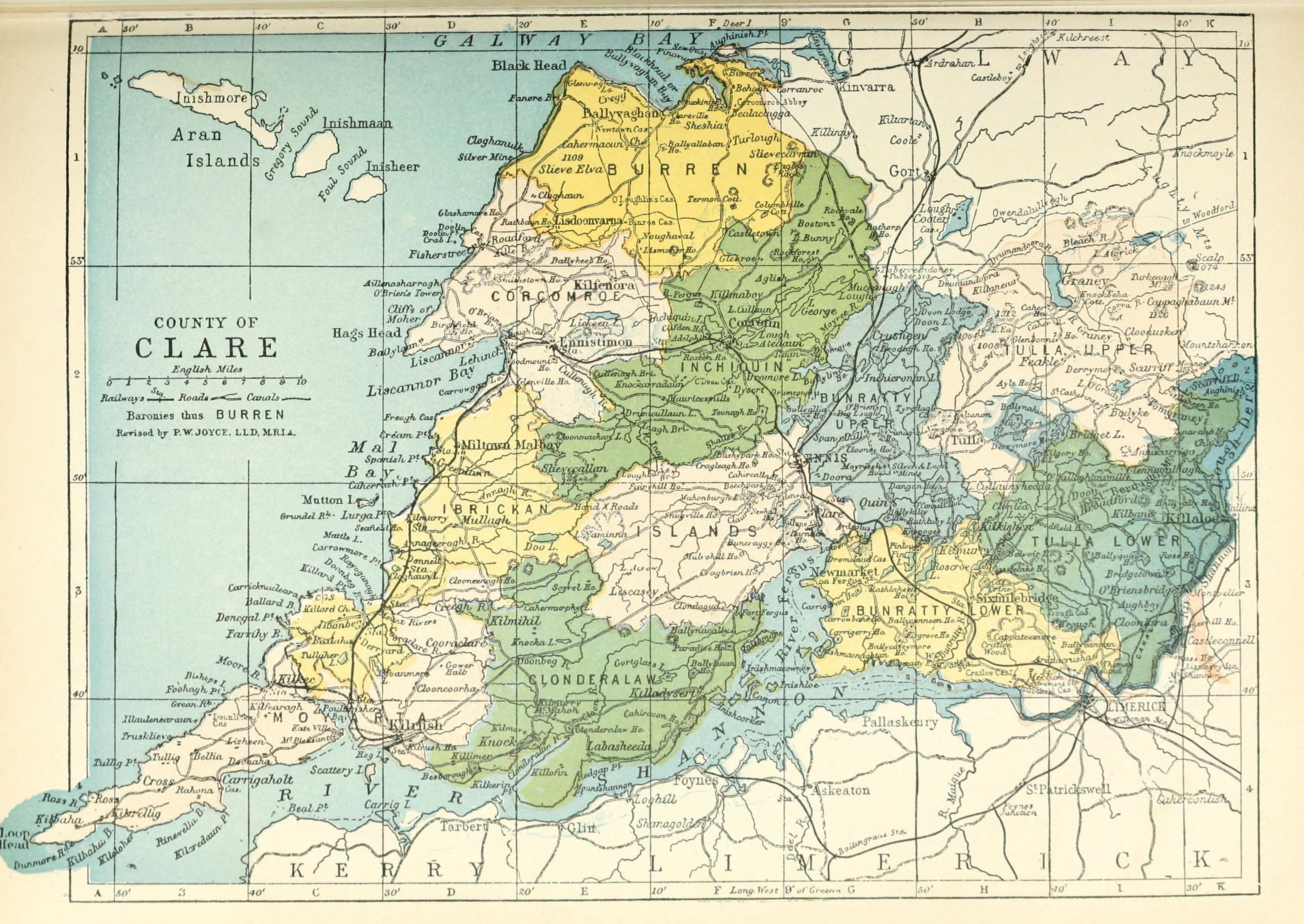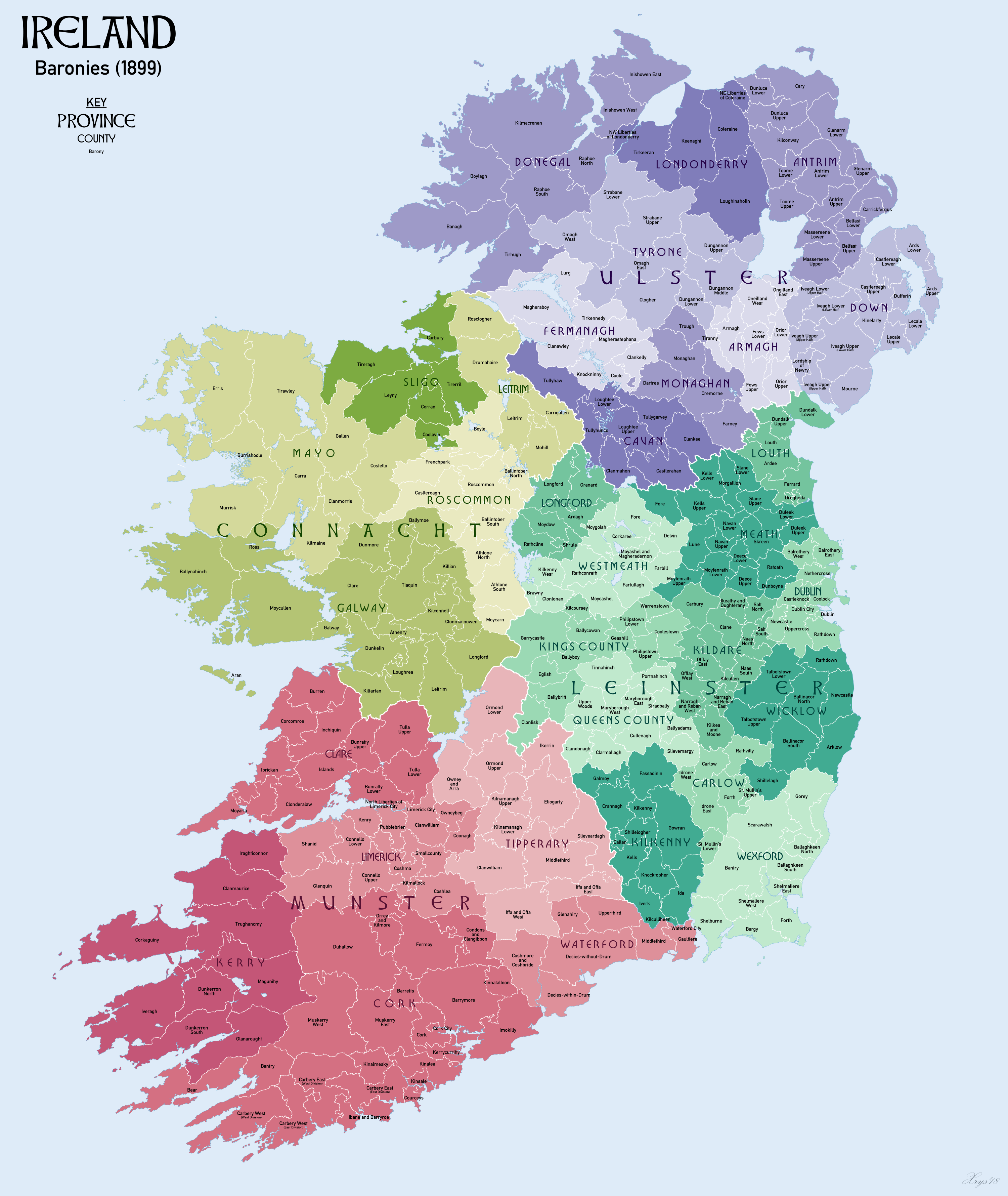|
Moyarta
Moyarta () is a civil parish in County Clare, Ireland. It lies on the Loop Head peninsula between the Atlantic Ocean and the Shannon Estuary. The parish contains the villages of Carrigaholt and Doonaha. Location The parish of Moyarta is situated in the barony of Moyarta of the same name on the Loop peninsula. It has land borders with two parishes - Kilballyowen to the west and Kilfearagh to the east. To the north of the peninsula is the Atlantic Ocean with the Shannon Estuary on the opposide side. It is and covered . The Atlantic coast is high and rocky and includes the small headlands of Castle-Point and Foohagh-Point. A large part of the surface is bog or moorland. The Moyarta River flows east through the parish from the parish of Kilballyowen to the head of Carrigaholt bay on the Shannon Estuary, a distance of . There are national schools, for children aged up to 12, in Carrigaholt, Doonaha, Moveen and Querrin. The civil parish contains the Catholic parish of Carrigaho ... [...More Info...] [...Related Items...] OR: [Wikipedia] [Google] [Baidu] |
Moyarta (barony)
The Barony of Moyarta is a geographical division of County Clare, Ireland, that in turn is divided into civil parishes. Legal context Baronies were created after the Norman invasion of Ireland as divisions of counties and were used the administration of justice and the raising of revenue. While baronies continue to be officially defined units, they have been administratively obsolete since 1898. However, they continue to be used in land registration and in specification, such as in planning permissions. In many cases, a barony corresponds to an earlier Gaelic túath which had submitted to the Crown. Location The Barony of Moyarta lies on a peninsula extending between the Atlantic Ocean to the west and the Shannon Estuary to the south, terminating at the point of Loop Head. On the north it is bound by the barony of Ibrickane and on the east by the barony of Clonderalaw. It covers of which are tideway of the Shannon. The land is rugged, containing much bog and moor. Parishes ... [...More Info...] [...Related Items...] OR: [Wikipedia] [Google] [Baidu] |
Kilballyowen
Kilballyowen () is the name of both a civil parish and a townland within that parish in County Clare, Ireland. The name is also occasionally used for the slightly larger Catholic parish of Cross. Kilballowen parish is located at the end of the Loop Head Peninsula which extends into the Atlantic Ocean to the north of the Shannon Estuary. The parish contains the villages of Cross and Kilbaha. On the first edition Ordnance Survey of Ireland map of 1840, other settlements in the parish such as Ross, Trusklieve and Tullig were marked as villages, but depopulation during and after the Great Famine have rendered these settlements relatively insignificant today. Location The parish is part of the historical barony of Moyarta. It is and covers . It has a land border with only one parish - the eponymous Moyarta of the same barony. Kilballyowen is west of Kilrush. Cliffs rise to at a point to the west of Rinevella bay. As of 1845 the parish held the ruins of a church and a friary ... [...More Info...] [...Related Items...] OR: [Wikipedia] [Google] [Baidu] |
County Clare
County Clare () is a Counties of Ireland, county in the Provinces of Ireland, province of Munster in the Southern Region, Ireland, Southern part of Republic of Ireland, Ireland, bordered on the west by the Atlantic Ocean. Clare County Council is the Local government in the Republic of Ireland, local authority. The county had a population of 127,938 at the 2022 census of Ireland, 2022 census. The county seat and largest settlement is Ennis. Etymology There are two main hypotheses for the origins of the county name "Clare". One is that the name is derived from Thomas de Clare, Lord of Thomond, Thomas de Clare an Anglo-Norman peer and soldier from the de Clare family, who was deeply embroiled in local politics and fighting in the 1270s and 1280 and had had acquired land in Kilkenny and Thomond that included the Castle of Clare. In 1590 County Clare was named after the castle, which is in a strategic location. An alternative hypothesis is that the county name ''Clare'' comes from ... [...More Info...] [...Related Items...] OR: [Wikipedia] [Google] [Baidu] |
Carrigaholt
Carrigaholt () is a small fishing village in County Clare, Ireland, a castle and a Catholic parish by the same name. The area was officially classified as part of the West Clare Gaeltacht; an Irish-speaking community; until 1956. Location Carrigaholt lies at the mouth of the Moyarta river, which flows into the estuary of the River Shannon about 15 km from the tip of the Loop Head peninsula and about 10 km from the resort town of Kilkee on the north coast of the peninsula. The village boasts a ruined castle that stood guard over the mouth of the Shannon and the local fishing pier. Economy Fishing is still continued in the village with a small number of boats delivering their catches to a local processing company. The village is also the local centre for the local farming community. The village has benefited recently from tourism, mainly provided by residents from Limerick some 110 km to the east. The village has two restaurants, a fast food take-away and four public ... [...More Info...] [...Related Items...] OR: [Wikipedia] [Google] [Baidu] |
Civil Parishes In Ireland
Civil parishes () are units of territory in the island of Ireland that have their origins in old Gaelic territorial divisions. They were adopted by the Anglo-Norman Lordship of Ireland and then by the Elizabethan Kingdom of Ireland, and were formalised as land divisions at the time of the Plantations of Ireland. They no longer correspond to the boundaries of Roman Catholic or Church of Ireland parishes, which are generally larger. Their use as administrative units was gradually replaced by Poor_law_union#Ireland, Poor Law Divisions in the 19th century, although they were not formally abolished. Today they are still sometimes used for legal purposes, such as to locate property in deeds of property registered between 1833 and 1946. Origins The Irish parish was based on the Gaelic territorial unit called a ''túath'' or ''Trícha cét''. Following the Norman invasion of Ireland, the Anglo-Normans, Anglo-Norman barons retained the ''tuath'', later renamed a parish or manor, as a un ... [...More Info...] [...Related Items...] OR: [Wikipedia] [Google] [Baidu] |
Eugene O'Curry
Eugene O'Curry (, 20 November 179430 July 1862) was an Irish philologist and antiquary. Life He was born at Doonaha, near Carrigaholt, County Clare, the son of Eoghan Ó Comhraí, a farmer, and his wife Cáit. Eoghan had spent some time as a travelling pedlar and had developed an interest in Irish folklore and traditional music. Unusually for someone of his background, he appears to have been literate and he is known to have possessed a number of Irish manuscripts. It is likely that Eoghan was primarily responsible for his son's education.Profile oxforddnb.com; accessed 22 November 2015. Having spent some years working on his father's farm and as a school teacher, Eugene O'Curry moved to Limerick around 1824 and spent seven years working there at a mental hospital. He married Anne Broughton, daughter of John Broughton of Killaderr ... [...More Info...] [...Related Items...] OR: [Wikipedia] [Google] [Baidu] |
Thomond
Thomond ( Classical Irish: ; Modern Irish: ), also known as the Kingdom of Limerick, was a kingdom of Gaelic Ireland, associated geographically with present-day County Clare and County Limerick, as well as parts of County Tipperary around Nenagh and its hinterland. The kingdom represented the core homeland of the Dál gCais people, although there were other Gaels in the area such as the Éile and Eóganachta, and even the Norse of Limerick. It existed from the collapse of the Kingdom of Munster in the 12th century as competition between the Ó Briain and the Mac Cárthaigh led to the schism between Thomond ("North Munster") and Desmond ("South Munster"). It continued to exist outside of the Anglo-Norman-controlled Lordship of Ireland until the 16th century. The exact origin of Thomond, originally as an internal part of Munster, is debated. It is generally held that the Déisi Muman pushed north-west starting from the 5th to the early 8th century, taking the area from the ... [...More Info...] [...Related Items...] OR: [Wikipedia] [Google] [Baidu] |
Cross, County Clare
Cross () is a townland and small village in County Clare, Ireland. It is in the Catholic parish of Cross. Location The village of Cross is located on the Loop Head Peninsula, west of Carrigaholt on the road to Kilbaha. It is the civil parish of Kilballyowen. The name could be derived from a cross related to the old church of Killballyowen. It is more likely that the village is named after a once important road crossing as Cross is located in the center of the Loop Head Peninsula. Facilities Cross is home of the local Gaelic Athletic Association (GAA) club. The GAA football club of Naomh Eoin was founded on 6 January 1974. It is based at Pairc Eoin. The village gives its name to the parish of Cross (Kilballyowen) in the Roman Catholic Diocese of Killaloe The Diocese of Killaloe ( ; ) is a Latin diocese of the Catholic Church in mid-western Ireland, one of six suffragan dioceses in the ecclesiastical province of Cashel and Emly. The cathedral church of the diocese is ... [...More Info...] [...Related Items...] OR: [Wikipedia] [Google] [Baidu] |
Atlantic Ocean
The Atlantic Ocean is the second largest of the world's five borders of the oceans, oceanic divisions, with an area of about . It covers approximately 17% of Earth#Surface, Earth's surface and about 24% of its water surface area. During the Age of Discovery, it was known for separating the New World of the Americas (North America and South America) from the Old World of Afro-Eurasia (Africa, Asia, and Europe). Through its separation of Afro-Eurasia from the Americas, the Atlantic Ocean has played a central role in the development of human society, globalization, and the histories of many nations. While the Norse colonization of North America, Norse were the first known humans to cross the Atlantic, it was the expedition of Christopher Columbus in 1492 that proved to be the most consequential. Columbus's expedition ushered in an Age of Discovery, age of exploration and colonization of the Americas by European powers, most notably Portuguese Empire, Portugal, Spanish Empire, Sp ... [...More Info...] [...Related Items...] OR: [Wikipedia] [Google] [Baidu] |
Barony (Ireland)
In Ireland, a barony (, plural ) is a historical subdivision of a counties of Ireland, county, analogous to the hundred (county subdivision), hundreds into which the counties of England were divided. Baronies were created during the Tudor reconquest of Ireland, replacing the earlier cantreds formed after the original Norman invasion of Ireland, Norman invasion.Mac Cotter 2005, pp.327–330 Some early baronies were later subdivided into half baronies with the same standing as full baronies. Baronies were mainly cadastre, cadastral rather than administrative units. They acquired modest local taxation and spending functions in the 19th century before being superseded by the Local Government (Ireland) Act 1898. Subsequent adjustments of county boundaries mean that some baronies now straddle two counties. The final catalogue of baronies numbered 331, with an average area of ; each county was divided, on average, into 10 or 11 baronies. Creation The island of Ireland was "shired" i ... [...More Info...] [...Related Items...] OR: [Wikipedia] [Google] [Baidu] |




